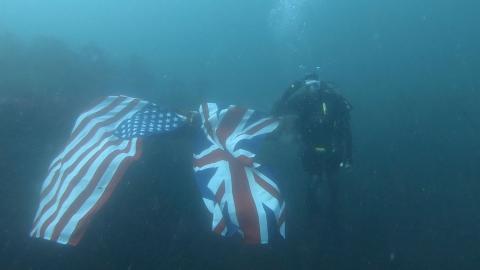Badlads Divers commemorate the sinking of HMS Otranto, underwater

Over 400 men lost their lives in one night when the HMS Otranto sank off the west coast of Islay. 100 years after the tragic sinking of the Otranto, Badlads Divers remember the loss of life in a special underwater commemoration.
On 6th October 1918, 431 people lost their lives off the west coast of Islay in Machir Bay. Just 8 months earlier, in February, over 200 men were lost when another ship, the HMS Tuscania was torpedoed by a German U-boat 6 miles off The Mull of Oa on Islay. These tragic wrecks, so close together had a lasting effect on the island community.
As scuba divers who have been diving off the Islay coast for years, Badlads Diving, a group based in Lancashire felt they had to do something special in remembrance themselves. They set out with one mission this year:
“At the going down of the sun and in the morning. We will remember them.” (For the Fallen by Robert Laurence Binyon)
From 8th - 15th June 2018, they used their yearly trip as an opportunity to honour and remember those who died just over a month before Armistice day. The team dived 54 hours mapping and recoding what remains of the HMS Otranto today, after 100 years beneath the waves.
This was by no means the first or only commemoration to the tragic loss of life
On 4th May 2018, WW100 Scotland National Day of Remembrance saw Princess Anne, descendants of survivors and UK government officials alongside British, American, French and German servicemen join together to commemorate the centenary of the tragic sinking of the HMS Tuscania and HMS Otranto in 1918 off the coast of Islay.
Pete Kenrick, who organises the Badlads annual diving trip to Islay was touched by the Tuscania and Otranto memorial and amazed that there was no recorded underwater footage of the Otranto wreck. Pete felt this presented the Badlads with an opportunity for a unique and fitting way to contribute to commemorations and honour those who died.
Due to their knowledge of the area, above and below the surface, they have seen the Otranto wreck on the floor of the seabed many times previously. However, aware of the centenary anniversary and that they have had a rare privilege to see where the Otranto lies now, the Badlads team decided that placing remembrance flags, recording and mapping the remains would be a fitting tribute.
It was Pete Kenrick who filmed the entirety of their 54 hours underwater. The hours of filming, while still available as raw footage, was reduced to a 21-minute video cataloguing their underwater expedition and commemoration. His edited video has been sent to the Museum of Islay Life alongside a few coins and loose tiles the divers found on their trip and donated to the museum to use in exhibitions. All valuable metals, fixtures and fittings have been long since recovered by Salvage Operations.
The importance of the underwater footage
15 meters below the surface, the Otranto foundered on Old Woman's Reef. The Badlads team have been to this site several times and despite the wreckage and debris covering an area greater than the size of two football pitches, they knew the area they were looking for initially to begin their tribute.
They dived towards the forward 6’ quick firing gun engulfed in kelp they had seen many times previously. And on that first dive, cleaned the gun of excess kelp to prepare the site for their tribute. Flags of the United States of America and Great Britain were hoisted. A salute was given in honour and memory as the flags side by side flew proudly in the swell and current. And the flags remained fastened there for the duration of Diving operations.
During the 21-minute memorial video, you’re taken on a journey through the wreck. You can see engines that stand 5 metres proud of the seabed, covered in kelp but their parts still recognisable, 4 boilers remain intact. The boiler fireboxes where tons of coal were once shovelled by hand to create steam to drive engines are still also clearly visible.
You witness steel plates and portholes, a ventilator grill, a collapsed boiler, electrical terminal name plates, propeller shafts and one of the propeller shaft bearing liners; 3rd class bathroom tiles, a deck winch, lifting cradle and hook, broken timbers and a soldier's boot resting on a strand of cordite.
Mike Armitage, one of the Badlads group said “The boot was one of the most striking sights, because you see it and it really makes you wonder, what happened to the owner – was he one of the lucky survivors? Was he one of the servicemen who perished? Seeing that made it very real for us divers.”
Pete’s brother, Jeff Kenrick remarked “It’s an incredible place to dive, I felt very privileged to be part of it this year particularly. For me, the most striking thing is that the site is teeming with sea life now. Lobsters, corals and fish have all just accepted it part of their environment now.”
On their last day diving, during their final dive, the team recovered the flags revealing the gun, now free of kelp and showing the 6” gun breech open, ready for loading. Leaving just the poppy they placed on there earlier in the week to honour the six French trawlermen who were also lost.
During their trip, the team also visited the Museum of Islay Life so they could learn more about the personal experiences of witnesses and survivors of the tragedy. They then went to the Otranto and Tuscania memorial erected by the American National Red Cross on The Mull of Oa and observed a minute silence.
